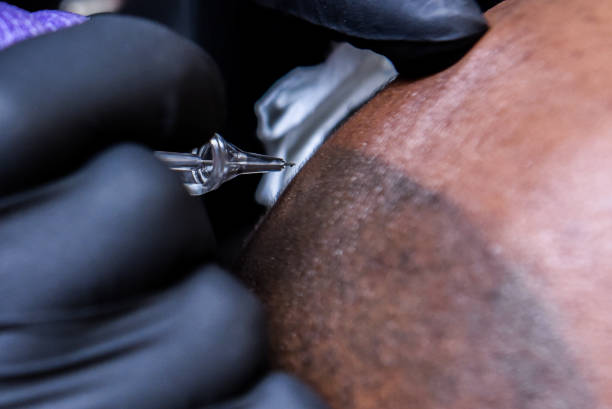Introduction to Scalp Micropigmentation (SMP)
Scalp Micropigmentation (SMP) is a revolutionary cosmetic procedure that offers a permanent solution to hair loss, providing individuals with a renewed sense of confidence and self-esteem. By understanding the process, benefits, and aftercare involved, individuals can make informed decisions about undergoing SMP and enhance their appearance effectively.
Understanding SMP
Definition and Purpose
SMP involves the application of specialized pigments to the scalp to create the appearance of hair follicles. It is designed to replicate the look of a closely shaved head or a fuller head of hair, depending on the client's preferences. SMP is suitable for individuals with various types of hair loss, including male pattern baldness, alopecia, and thinning hair.
How SMP Works
During an SMP procedure, a skilled specialist uses micro-needles to deposit pigment into the scalp at varying depths, creating the illusion of hair follicles. The pigments are carefully matched to the client's natural hair color to ensure a seamless and realistic result. SMP can be customized to achieve the desired hairline shape, density, and color, providing clients with a personalized solution to their hair loss concerns.
Benefits of SMP
Restoring Hairline
One of the primary benefits of SMP is its ability to restore a natural-looking hairline for individuals experiencing receding hairlines or balding. SMP creates the appearance of hair follicles along the hairline, framing the face and enhancing facial features.
Camouflaging Hair Loss
SMP is highly effective in camouflaging areas of hair loss or thinning hair, such as the crown or vertex of the scalp. By blending seamlessly with existing hair follicles, SMP creates the illusion of fuller, thicker hair, providing individuals with a renewed sense of confidence.
Boosting Confidence
Perhaps the most significant benefit of SMP is its ability to boost confidence and self-esteem. For individuals struggling with hair loss, SMP offers a permanent solution that allows them to feel more confident in their appearance and regain a sense of control over their hair loss.
Preparing for SMP
Consultation with a Specialist
Before undergoing SMP, it is essential to schedule a consultation with a qualified SMP specialist. During this consultation, the specialist will assess the client's scalp, discuss their goals and expectations, and recommend the most suitable treatment plan.
Pre-treatment Guidelines
Clients will receive pre-treatment guidelines to follow, which may include avoiding certain medications or supplements that can thin the blood and increase the risk of bleeding during the procedure.
The SMP Procedure
Application Process
During the SMP procedure, the specialist carefully maps out the desired hairline and density using a specialized template. The pigment is then deposited into the scalp using a micro-needling technique, creating natural-looking hair follicles.
Duration and Sensation
The duration of an SMP procedure can vary depending on the extent of the treatment area and the desired results. Most sessions last between two to four hours, and clients may experience mild discomfort or tingling sensations during the procedure.
Aftercare and Recovery
Post-treatment Care
After undergoing SMP, clients must follow their specialist's post-treatment care instructions carefully. This may include avoiding exposure to sunlight, refraining from strenuous activities, and using gentle skincare products to prevent irritation.
Managing Expectations
While SMP can produce remarkable results, it is essential for clients to have realistic expectations about the outcome of the procedure. SMP is not a permanent solution to hair loss, and additional sessions may be required to maintain the desired appearance.
Choosing the Right Clinic in Abu Dhabi
Reputation and Expertise
When selecting a clinic for SMP in Abu Dhabi, clients should consider factors such as the clinic's reputation, experience, and expertise in performing SMP procedures. It is essential to choose a clinic that specializes in scalp micropigmentation and has a track record of delivering natural-looking results.
Safety and Hygiene Standards
Clients should ensure that the chosen clinic adheres to strict safety and hygiene standards to minimize the risk of complications and ensure a comfortable, stress-free experience. This includes using sterile equipment, following proper disinfection protocols, and providing personalized care tailored to the client's needs.
Conclusion
Scalp Micropigmentation Abu Dhabi offers individuals a safe, effective, and long-lasting solution to hair loss, allowing them to enhance their appearance and regain their confidence. By understanding the benefits, preparation, procedure, and aftercare involved, individuals can make informed decisions about undergoing SMP and enjoy the transformative effects it offers.
FAQs
- Is SMP suitable for all types of hair loss?
- SMP can be effective for various types of hair loss, including male pattern baldness, alopecia, and thinning hair. However, it is essential to consult with a qualified SMP specialist to determine suitability.
- How long do SMP results last?
- SMP results are semi-permanent and can last for several years with proper care and maintenance. Touch-up sessions may be required every few years to maintain the desired appearance.
- Is SMP painful?
- While some discomfort may be experienced during the SMP procedure, it is generally well-tolerated by most individuals. Your specialist can provide numbing creams or local anesthesia to minimize any discomfort.
- Can SMP be reversed or corrected if I'm unhappy with the results?
- In some cases, SMP can be partially or fully reversed using specialized techniques such as laser tattoo removal. However, it is essential to choose a skilled and experienced SMP specialist to minimize the risk of dissatisfaction.
- How soon can I resume normal activities after SMP?
- Most individuals can resume normal activities immediately after SMP, although it is recommended to avoid strenuous exercise and exposure to direct sunlight for the first few days following the procedure.





Comments